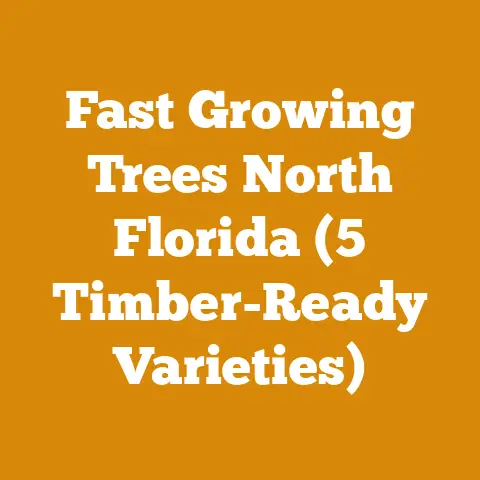Stihl HT-101 Pole Saw Guide (5 Pro Tips for Tree Work)
Here’s a paradox for you: to reach for the sky, you sometimes need to cut back the trees.
It seems counterintuitive, doesn’t it?
But in the world of arboriculture, tree care, and even firewood preparation, that’s often the reality.
And that’s where the Stihl HT-101 pole saw comes in – a tool that allows us to manage trees safely and efficiently, even from the ground.
I’ve spent years working with various chainsaws, axes, and log splitters, but the pole saw holds a special place in my toolkit.
It’s not just about cutting branches; it’s about precision, safety, and accessibility.
In this guide, I’ll share my top 5 pro tips for tree work using the Stihl HT-101 pole saw, drawing from my experiences and knowledge in wood processing and firewood preparation.
Stihl HT-101 Pole Saw Guide (5 Pro Tips for Tree Work)
The Stihl HT-101 pole saw is a powerful tool for trimming and pruning trees from the ground.
It extends your reach, allowing you to tackle branches that would otherwise require climbing or using a ladder.
This dramatically improves safety and efficiency, especially for tasks like removing deadwood, thinning crowns, or clearing branches near power lines (always consult a professional for power line work).
This guide will cover essential techniques to help you master the HT-101 and work with confidence.
1. Mastering the Basics: Safety First and Proper Technique
Before even thinking about cutting, safety is paramount.
I’ve seen too many accidents happen because of carelessness or lack of preparation.
Safety Gear is Non-Negotiable
- Helmet: A forestry helmet with a face shield and ear protection is absolutely essential.
Falling debris is a constant hazard.
I remember one instance where a seemingly small twig fell and hit my helmet with surprising force.
Without it, I would have sustained a serious head injury. - Eye Protection: If you prefer safety glasses to a face shield, ensure they are ANSI-rated for impact resistance.
- Hearing Protection: The HT-101 can be quite loud.
Earplugs or earmuffs will protect your hearing. - Gloves: Sturdy work gloves will improve your grip and protect your hands from cuts and abrasions.
- Long Sleeves and Pants: Protect your skin from scratches and insect bites.
- Steel-Toed Boots: Provide crucial foot protection.
- High-Visibility Clothing: Especially important if working near roads or in low-light conditions.
Understanding the HT-101
- Familiarize yourself with the manual: Seriously, read it!
It contains important information about assembly, operation, maintenance, and safety. - Check the chain tension: A loose chain can derail and cause injury.
The chain should have a slight sag but not be so loose that it comes off the bar.
I typically check this before each use and after every few cuts. - Lubricate the chain: Use bar and chain oil specifically designed for chainsaws.
Proper lubrication reduces friction and extends the life of the chain and bar.
I prefer biodegradable bar and chain oil for environmental reasons. - Inspect the pole: Ensure all sections are securely locked and that there are no cracks or damage.
- Practice on the ground: Before tackling overhead branches, practice starting, stopping, and maneuvering the pole saw on the ground to get a feel for its weight and balance.
The Right Stance and Grip
- Stable footing: Position yourself on a stable surface with good footing.
Avoid uneven ground or slippery surfaces. - Two-handed grip: Always use both hands to control the pole saw.
This provides better balance and control. - Shoulder support: Rest the pole against your shoulder for added stability and reduced fatigue.
- Avoid overreaching: Do not extend the pole so far that you lose control.
It’s better to reposition yourself than to risk an accident.
Cutting Techniques: The Basics
- Undercut first: When cutting larger branches, make a small undercut first to prevent the bark from tearing when the branch falls.
This is crucial for maintaining the health and appearance of the tree. - Top cut second: Complete the cut with a top cut, slightly above the undercut.
- Controlled descent: Allow the branch to fall in a controlled manner.
Be aware of the surroundings and ensure that no one is in the path of the falling branch. - Avoid pinching: If the saw starts to pinch, stop and reposition yourself.
You may need to use a wedge to keep the cut open.
Case Study: Pruning an Apple Tree
I once worked on an old apple tree that was overgrown and not producing much fruit.
Using the HT-101, I was able to selectively prune the branches, removing deadwood and opening up the canopy to allow more sunlight to reach the remaining branches.
The result was a healthier, more productive tree.
The key was careful planning and precise cuts, following the natural growth patterns of the tree.
I started by removing any crossing or rubbing branches to improve air circulation.
Then, I thinned out the canopy to allow sunlight to penetrate.
Finally, I shortened some of the longer branches to encourage new growth.
This case highlights the importance of careful planning and precise execution when using a pole saw.
2. Advanced Cutting Techniques: Limb Walking and Avoiding Kickback
Once you’re comfortable with the basics, you can start to explore more advanced techniques.
Limb Walking
“Limb walking” is a technique where you make a series of small cuts along the length of a branch, gradually shortening it before making the final cut at the trunk.
This reduces the weight of the branch and makes it easier to control its descent.
- Start at the tip: Begin by making small cuts at the tip of the branch, working your way back towards the trunk.
- Reduce weight: Each cut should remove a small section of the branch, gradually reducing its weight.
- Control the descent: As you shorten the branch, be aware of its balance and how it will fall.
- Final cut: Once the branch is significantly lighter, make the final cut at the trunk, using the undercut/top cut technique.
I find this technique particularly useful for removing large, heavy branches that could cause damage if they fell in one piece.
It also reduces the risk of kickback.
Understanding and Avoiding Kickback
Kickback is a sudden, violent upward or backward motion of the chainsaw that can occur when the tip of the bar comes into contact with a solid object.
It’s one of the most common causes of chainsaw injuries.
- The kickback zone: The upper quadrant of the bar tip is the most dangerous area.
Avoid using this part of the bar when cutting. - Maintain a clear line of sight: Keep a clear view of the cutting area and avoid cutting in blind spots.
- Use a low-kickback chain: Some chains are designed with features that reduce the risk of kickback.
- Keep the chain sharp: A dull chain is more likely to kick back.
- Avoid pinching: Pinching can also cause kickback.
Use wedges to keep the cut open if necessary.
Case Study: Removing a Hazardous Branch
I was once called to remove a large, dead branch that was hanging precariously over a house.
The branch was too high to reach with a regular chainsaw, and climbing the tree was not an option due to its condition.
Using the HT-101 and the limb walking technique, I was able to safely and efficiently remove the branch without causing any damage to the house.
I started by making small cuts at the tip of the branch, gradually working my way back towards the trunk.
As I shortened the branch, I carefully controlled its descent, ensuring that it fell away from the house.
The key was to take my time and to be aware of the potential hazards.
3. Optimizing Your HT-101: Maintenance and Modifications
Proper maintenance is crucial for keeping your HT-101 running smoothly and safely.
Regular Maintenance
- Clean the air filter: A dirty air filter restricts airflow and reduces engine performance.
Clean the air filter regularly with compressed air or warm soapy water. - Clean the spark plug: A fouled spark plug can cause starting problems.
Clean the spark plug with a wire brush or replace it if necessary. - Sharpen the chain: A sharp chain cuts more efficiently and reduces the risk of kickback.
Sharpen the chain regularly with a chainsaw file or a chain grinder.
I prefer using a chainsaw file in the field because it’s portable and doesn’t require electricity. - Check the bar: Inspect the bar for wear and damage.
Replace the bar if it is worn or damaged. - Lubricate the gearbox: The gearbox should be lubricated regularly with grease.
- Store properly: When not in use, store the HT-101 in a dry place.
Drain the fuel tank or add a fuel stabilizer to prevent fuel from going stale.
Modifications and Upgrades
- Different bar lengths: The HT-101 is available with different bar lengths.
Choose a bar length that is appropriate for the size of the branches you will be cutting.
I find the 12-inch bar to be a good all-around choice. - Different chains: There are many different types of chainsaw chains available.
Choose a chain that is appropriate for the type of wood you will be cutting.
For example, a ripping chain is designed for cutting wood along the grain, while a crosscut chain is designed for cutting wood across the grain. - Aftermarket accessories: There are many aftermarket accessories available for the HT-101, such as carrying cases, chain sharpeners, and fuel cans.
Case Study: Extending the Life of My HT-101
I’ve had my HT-101 for over 10 years, and it’s still going strong.
The secret to its longevity is regular maintenance.
I clean the air filter and spark plug after every use, sharpen the chain regularly, and lubricate the gearbox every few months.
I also store it properly when not in use.
By taking care of my HT-101, I’ve saved myself a lot of money on repairs and replacements.
4. Wood Selection and Processing: From Tree to Firewood
The HT-101 is not just for pruning; it can also be used for preparing firewood.
Understanding wood types and processing techniques is crucial for efficient and safe firewood production.
Green Wood vs. Seasoned Wood
- Green wood: Freshly cut wood that contains a high moisture content.
It’s heavy, difficult to split, and doesn’t burn well. - Seasoned wood: Wood that has been allowed to dry for several months or years.
It’s lighter, easier to split, and burns hotter and cleaner.
The ideal moisture content for firewood is below 20%.
You can use a moisture meter to check the moisture content of your wood.
Wood Types and Their Properties
- Hardwoods: Dense woods like oak, maple, and ash.
They burn hotter and longer than softwoods.
Oak is my personal favorite for its high heat output and long burn time. - Softwoods: Less dense woods like pine, fir, and spruce.
They burn faster and produce more smoke than hardwoods.
They are, however, easier to ignite.
The best type of wood for firewood depends on your specific needs and preferences.
Hardwoods are generally preferred for their higher heat output and longer burn time, but softwoods can be a good option for kindling or for burning in milder weather.
Processing Firewood
- Felling: The process of cutting down a tree.
This is a dangerous task that should only be performed by experienced individuals. - Bucking: The process of cutting a felled tree into shorter lengths.
This is where the HT-101 can be useful for cutting smaller diameter logs and branches. - Splitting: The process of splitting logs into smaller pieces.
This can be done with an axe, a maul, or a log splitter.
I use a hydraulic log splitter for larger logs and an axe for smaller pieces. - Stacking: The process of stacking firewood in a way that allows it to dry properly.
- Drying: The process of allowing firewood to dry.
This can take several months or even years, depending on the type of wood and the climate.
Case Study: Firewood Production from Start to Finish
I recently harvested a dead oak tree from my property and processed it into firewood.
I started by felling the tree, taking care to avoid any hazards.
Then, I bucked the tree into 16-inch lengths using my chainsaw.
Next, I split the logs using my hydraulic log splitter.
Finally, I stacked the firewood in a well-ventilated area to dry.
The entire process took several days, but the result was a large pile of high-quality firewood that will keep my family warm all winter long.
I estimated the yield from that single tree to be about 2 cords of wood.
5. Strategic Advantages: Efficiency, Safety, and Accessibility
Using the HT-101 offers several strategic advantages in tree work and firewood preparation.
Increased Efficiency
The HT-101 allows you to reach branches that would otherwise require climbing or using a ladder, saving you time and effort.
It also allows you to work more efficiently by reducing the need to move around the tree.
Improved Safety
Working from the ground reduces the risk of falls and other accidents associated with climbing trees.
The HT-101 also allows you to maintain a safe distance from falling branches.
Enhanced Accessibility
The HT-101 allows you to access branches in tight spaces or difficult-to-reach areas.
This is particularly useful for pruning trees near buildings or power lines.
Cost-Effectiveness
While the initial investment in an HT-101 can be significant, it can save you money in the long run by reducing the need for professional tree services.
It also allows you to process your own firewood, saving you money on heating costs.
Case Study: Using the HT-101 to Clear a Property Line
I was once hired to clear a property line that was overgrown with trees and brush.
The property line was located in a steep, rocky area that was difficult to access.
Using the HT-101, I was able to clear the property line quickly and efficiently, without having to climb any trees or navigate the treacherous terrain.
The HT-101 allowed me to work safely and effectively in a challenging environment.
The client was very happy with the results, and I was able to complete the job in a fraction of the time it would have taken using traditional methods.
Strategic Considerations for Small Businesses
For small logging or tree service businesses, the HT-101 represents a cost-effective way to expand service offerings without investing in expensive bucket trucks or aerial lifts.
It allows a small crew to handle a wider range of jobs, from basic pruning to storm cleanup, increasing revenue potential.
The key is to train employees properly and prioritize safety to minimize risks and maximize productivity.
Cost Analysis: HT-101 vs. Hiring a Professional
Let’s say you have a large tree in your yard that needs pruning.
Hiring a professional tree service could cost you anywhere from $500 to $1500, depending on the size and complexity of the job.
The Stihl HT-101 costs around $800 to $1200.
If you plan to do tree work regularly, the HT-101 could pay for itself in just a few jobs.
Additionally, the ability to process your own firewood can save you hundreds of dollars per year on heating costs.
Next Steps
Now that you have a solid understanding of how to use the Stihl HT-101 pole saw, it’s time to put your knowledge into practice.
Start by practicing the basic cutting techniques on the ground.
Then, gradually work your way up to tackling more challenging tasks.
Remember to always prioritize safety and to take your time.
With practice and patience, you’ll be able to use the HT-101 to safely and efficiently manage your trees and prepare your own firewood.
- Invest in the right safety gear.
- Familiarize yourself with the Stihl HT-101 manual.
- Practice the basic cutting techniques.
- Start with small projects and gradually work your way up to larger ones.
- Always prioritize safety.
- Consider taking a chainsaw safety course.
The Stihl HT-101 is a powerful tool that can make tree work and firewood preparation easier and safer.
By following these pro tips, you can master the HT-101 and take your tree care skills to the next level.
Remember, responsible tree management benefits not only your property but also the environment around you.






